How Far and How Fast Will Cases Go Down?
Saturday’s numbers reported yesterday evening round out the previous week with the addition of this week’s Sunday and Monday. All the indicators KHPI monitors are moving in the right direction– in some cases at record breaking speeds. Last week 48,664 net new cases were added to the running total of Confirmed and Probable cases– 61% of the number of cases the week before and lower than the previous 4 weeks of the Omicron surge. Including data through yesterday, the daily count on every individual weekday is lower than each of the preceding weeks. The 7-Day average of new cases is falling below the 14-Day average much faster than at any time in our epidemic with a difference on Saturday of 2142 cases. Semi-log plots of net cases show a negative rate of epidemic expansion. The test Positivity Rate is falling sharply as well.
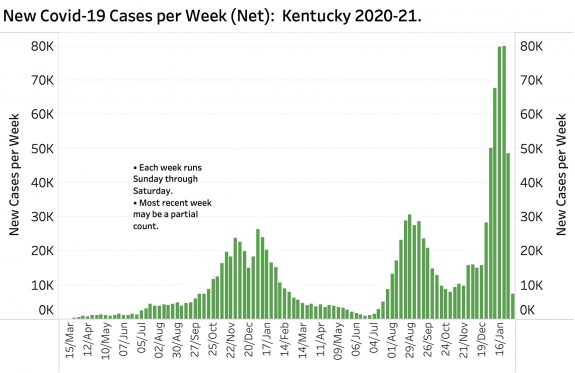
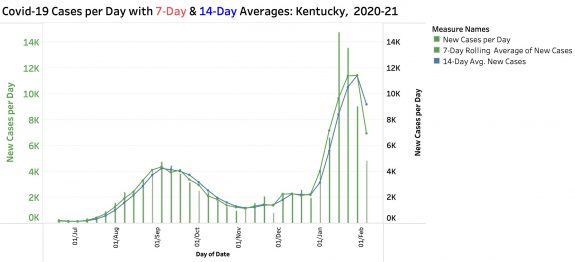
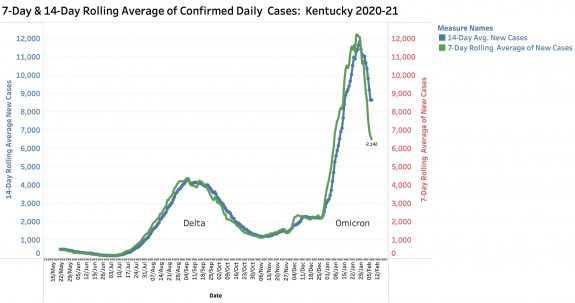
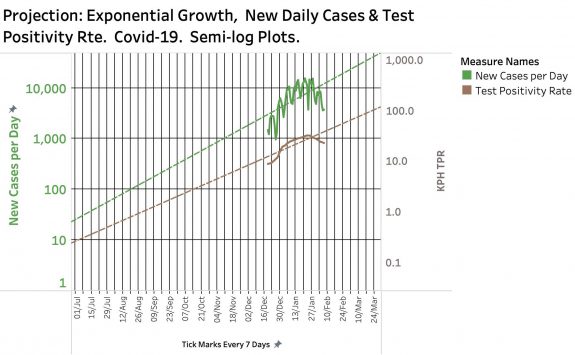
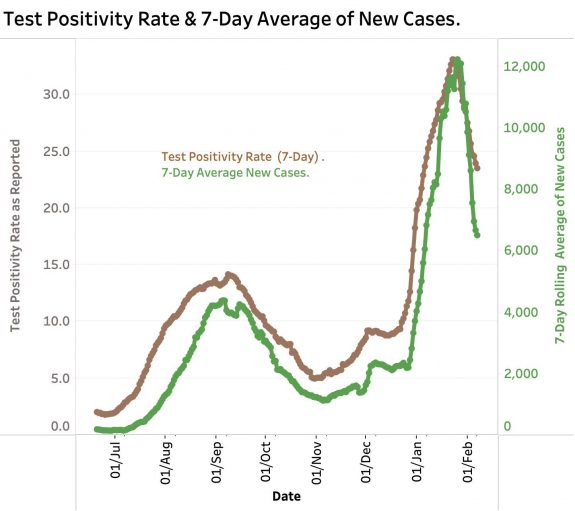
All this is good news, except all the indicators indicate epidemic activity higher than at any time in the previous 691 days of Kentucky’s epidemic! Furthermore, Governor Beshear shared a reservation yesterday that coming on the heels of last week’s severe ice storm, that the collection, analysis, and reporting of data may have been disturbed in the direction of undercounting cases. This is a legitimate concern. If no tests are reported, there will be no confirmed cases, only clinically ‘probable’ cases which would be similarly vulnerable to external circumstances if not more so. In the new KHPI data visualization below, it is clear that for the duration of the Omicron surge so far, that there is a strong correlation between reported numbers of tests done (of all types) and cases per day. Noteworthy is the demonstration that the number of both tests and cases reported last Sunday and yesterday were among the very lowest in the Omicron interval. [You can interactively explore the data for this visualization and other metrics on KHPI’s Tableau Public website.]
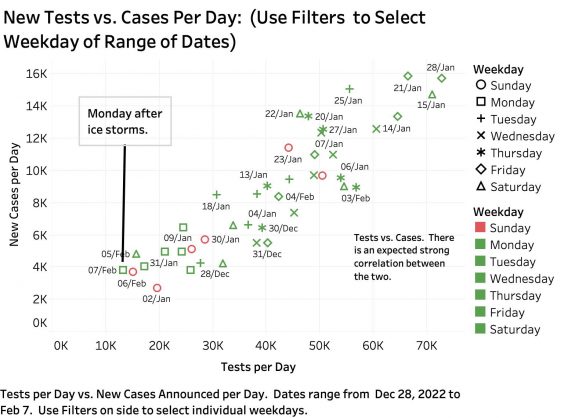
Hospitals?
It is too soon to be very definitive about hospital utilization. While some ticks downward appear in the various graphs of hospital, ICU and ventilator censuses, those numbers are also vulnerable to both to weekends and ice. Reports of the rest of the week will give us more confidence. We expect hospitalizations will lag cases.
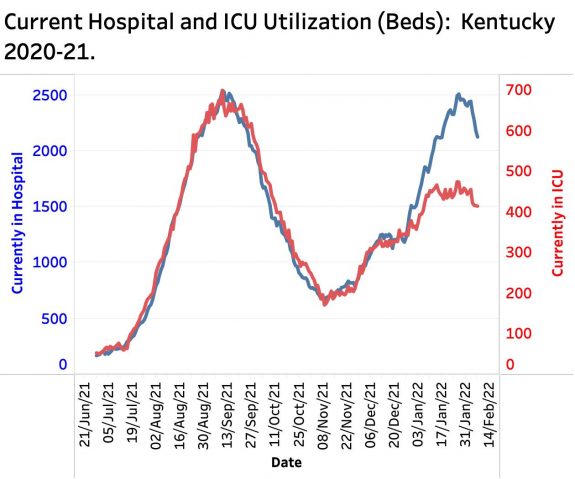
Deaths?
Little can be predicted with any confidence about deaths even though we believe the Omicron is not as immediately dangerous as Delta or Alpha. So far, the ability to identify, classify, and report Covid -19 deaths in Kentucky is quite unpredictable and eratic. The visualization below shows catch-up spikes of deaths extending well into the intervals between epidemic spikes. If history constrains the future, it will be months before we see the total impact of Omicron in death or disablility.
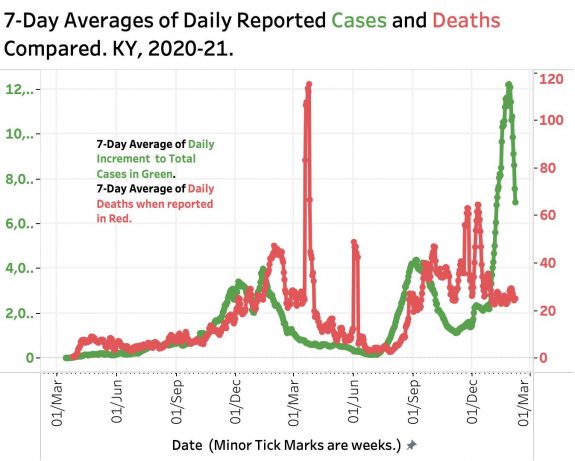
School Age?
Bad weather and tornados keep students out of school. In recent weeks some 25% of all new reported cases were in individuals 18 and under. This age group comprises the least vaccinated people in the state. When school started last fall, more than 30% of all pre-Omicron cases were in this age group. We should expect Omicron and any variant with that is even partially as contagious to run rampant in schools. Without appropriate attention and precautions, having kids in schools could be comparable to hosting chickenpox parties! Balancing risk against physical, emotional, and social damage from disease is one of the most difficult societal decisions we have to make. It cannot be done rationally without good data and confidence in our ability to do something effective and worthwhile. In our disjointed general and public health systems, such data has not been at hand. Single nationwide healthcare system anyone?
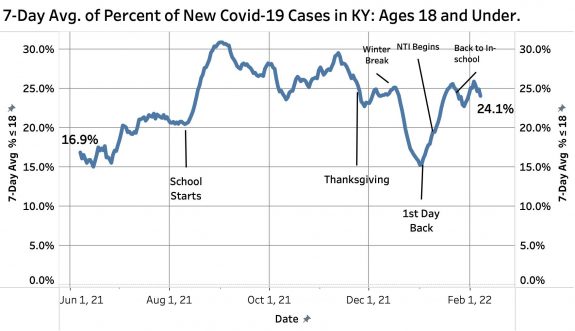
As emphasized in my last article in this series, while peak maximums are intrinsically attention-grabbing, the area under the curves (or put another way, the sum of all the weekly cases in the interval of interest) is of equal or greater clinical or societal importance than peaks. We already know that the Omicron variant is one of the very most infectious/contagious viruses known to man. What happens next when most of us Kentuckians have been exposed/infected remains to be seen. The downward curve of 7-Day average new cases may turn out to be as broad at the base as was Delta. An as-yet unnamed cousin or sibling variant strain I dub Omicron Jr. is currently displacing Omicron Sr. in some European countries. How soon or how bad the variants of the future will be is unknown and unpredictable. We will feel reassured that Omicron is receding and let down our guards as we have before. I personally hope to travel to Europe this spring, but I am glad we paid extra for cancel-for-any-reason travel insurance. The willingness of individual members of our society to protect each other is not something that can be “modeled.”
Peter Hasselbacher. MD
Emeritus Professor of Medicine, UofL
8 February, 2022
